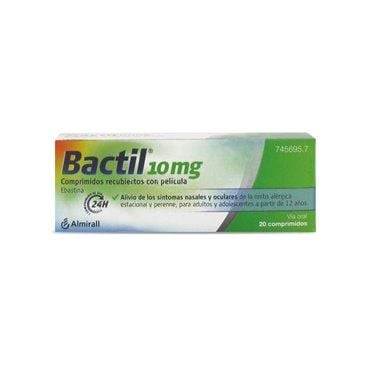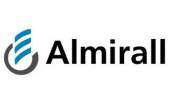Bactil (Ebastine) 10 Mg 20 Coated Tablets
Relief of nasal and ocular symptoms of park and perennial allergic rhinitis, for adults and adolescents from 12 years.
Relief of nasal and ocular symptoms of park and perennial allergic rhinitis, for adults and adolescents from 12 years.
Bactil (Ebastine 10 Mg 20 Coated Tablets)
ACTION AND MECHANISM
- [ANTIALERGICO], [HISTAMINERGICO ANTAGONIST (H-1)]. Ebastine is a piperidine derivative that potently, competitively, reversibly, and specifically blocks H1 receptors, reducing the systemic effects of histamine for a long time. It results in vasoconstriction and decreased vascular permeability, reducing redness and edema associated with allergy. Partially mitigates symptoms associated with allergic processes such as eye redness or nasal congestion. It also produces a slight bronchodilator effect and a decrease in skin itching. Clinical experience also appears to show that ebastine is capable of preventing histamine release from mast cells.
Ebastine is barely able to cross the blood-brain barrier, therefore it practically lacks significant sedative effects. It has great selectivity for H1 receptors, lacking significant anticholinergic and antiserotonergic effects. Similarly, no effects on the heart have been found in clinical trials, using doses up to 100 mg.
PHARMACOKINETICS
Orally:
- Absorption: Ebastine is rapidly absorbed in the intestine after oral administration, undergoing an intense hepatic first pass effect that generates an active metabolite, carebastine. The Cmax of ebastine obtained after administering a dose of 20 mg is 2.8 ng / ml, whereas after administering a dose of 10 mg, a caremax Cmax of 80-100 ng / ml is reached at 2.6-4 hours. Antihistamine activity begins after 1-3 hours, is maximum at 8-12 hours, and can last up to 48 hours. After stopping a 5-day treatment, antihistaminic effects were observed for 72 hours, due to the metabolites of ebastine, mainly carebastine.
Food: Food increases the AUC of the carebastine by 1.5-2 times, although this increase does not modify the Tmax. Administration of ebastine with food does not significantly alter its clinical effect.
- Distribution: Ebastine and carebastine bind strongly to plasma proteins (95%).
- Metabolism: Ebastine is intensively metabolized by the CYP3A4 isoenzyme, giving rise to the active metabolite carebastine.
- Elimination: Ebastine is eliminated mainly by liver metabolism. 66% of the dose appears in urine, mainly in the form of conjugated metabolites. It can also appear in small amounts in the stool (6%). The elimination half-life of carezine is 15-19 hours.
No significant pharmacokinetic differences have been observed between patients over 65 years of age and young, or between individuals with different degrees of kidney or liver failure compared to healthy patients.
INDICATIONS
- [SEASONAL ALLERGIC RHINITIS] or [PERENNIAL ALLERGIC RHINITIS], associated or not with [ALLERGIC CONJUNTIVITIS].
- [URTICARIA CHRONIC IDIOPATICA].
- [ALLERGIC CONTACT DERMATITIS].
POSOLOGY
"TABLETS"
- Adults, oral: 10-20 mg / 24 h.
- Children and adolescents under 18 years of age, oral:
* Adolescents from 12 years old: no dosage adjustment is required.
- Elderly, oral: no dosage adjustment is required.
Administration with food: can be taken with or without food.
Duration of treatment: until symptoms disappear.
Missed dose: skip the missed dose and administer the next dose at the usual time. Do not double the next dose.
POSOLOGY IN KIDNEY FAILURE
No dosage adjustment is required.
POSOLOGY IN LIVER FAILURE
- Mild to moderate hepatic impairment (Child-Pugh class A): no dosage adjustment is required.
- Severe hepatic impairment (Child-Pugh class C): maximum dose 10 mg / 24 h.
RULES FOR THE CORRECT ADMINISTRATION
"TABLETS"
Swallow the tablets whole, with the help of a glass of liquid, preferably water.
CONTRAINDICATIONS
- Hypersensitivity to any component of the drug. There may be cross reactions with other antihistamines, so it is not recommended to use any H1 antihistamine in patients who have presented hypersensitivity to any compound in the group.
- [PORPHYRIA]. H1 antihistamines have been associated with the appearance of porphyric outbreaks, so they are not considered safe in these patients.
PRECAUTIONS
- [LIVER FAILURE]. Ebastine is extensively metabolized in the liver. In case of liver failure, an increase in plasma concentration may occur. It is recommended not to exceed the dose of 10 mg / 24 hours in patients with severe hepatic impairment, while in those with mild or moderate insufficiency it is not necessary to take any measures, although it is advisable to monitor these patients (See Dosage).
- [CARDIAC ARRHYTHMIA]. Patients at cardiac risk, such as those with [BRADICARDIA], [QT INTERVAL PROLONGATION], with [HYPOPOTASEMIA] or in treatment with drugs that affect the QT interval or inhibit ebastine metabolism (See Interactions). In clinical trials it has been found that ebastine does not have significant effects on the heart at doses up to 100 mg / 24 hours, but it cannot be ruled out, therefore monitoring of cardiac functionality is recommended in these patients.
- [EPILEPSY]. Caution should be exercised in epileptic patients, since antihistamines have occasionally been associated with paradoxical hyperexcitability reactions, even at therapeutic doses, so they could lower the seizure threshold.
- Photosensitivity. Ebastine could give rise to photosensitivity phenomena, so it is recommended not to sunbathe during treatment, and protect yourself with sunscreens.
- Acute allergic processes. Due to the fact that ebastine can take around three hours to present pharmacological effects, its use is not recommended in severe acute allergic processes.
PRECAUTIONS RELATED TO EXCIPIENTS
- This medicine contains lactose. Patients with hereditary or galactose [LACTOSE INTOLERANCE], Lapp lactase deficiency, or glucose or galactose malabsorption should not take this medicine.
- This medicine contains lactose. Intake of amounts greater than 5 g daily should be taken into account in patients with [DIABETES] and with intolerance to certain sugars.
ADVICE TO THE PATIENT
- It is recommended to administer this medicine every day at the same time.
- The recommended dose should not be exceeded, since sedation may appear.
- It is advisable not to sunbathe during the treatment.
SPECIAL WARNINGS
- Due to the antiallergic effects of this medicine, it could give false negatives in dermal tests for hypersensitivity to antigenic extracts. It is recommended to stop taking this medicine at least 72 hours before the test.
- It is recommended to monitor cardiac functionality and the electrocardiogram in patients with heart disease or in those receiving ebastine together with erythromycin, ketoconazole or antiarrhythmic drugs, at the risk of prolongation of the QTc interval.
INTERACTIONS
No drug interactions with ebastine have been observed. The use of ebastine together with alcohol has not been shown to increase sedation. However, due to the risk of photosensitivity reactions due to consumption of H1 antihistamines, ebastine could potentiate the photosensitizing effects of other drugs.
- Erythromycin, ketoconazole. There have been some cases of slight prolongation of the QTc interval of about 10 msec. It is unknown whether this effect is due to enzymatic inhibition of CYP3A4 by macrolides or azole antifungals, or to the heart effects of these drugs themselves. It is recommended to exercise extreme caution in patients receiving ebastine together with any of these drugs.
PREGNANCY
Safety in pregnant women: There have been no adequate and well-controlled studies in humans. There are reports of a possible association between the use of antihistamines in general during the last two weeks of pregnancy and an increased risk of retrolental fibroplasia in premature infants, although there is insufficient clinical data to demonstrate this. The use of this medicine is only accepted in the absence of safer therapeutic alternatives.
Effects on fertility: no foetotoxic or teratogenic effects of ebastine have been found in animal studies
LACTATION
It is unknown whether ebastine is excreted in milk, but other antihistamines do. Due to the risk of adverse reactions in the infant, it is recommended to stop breastfeeding or avoid the administration of this medicine.
CHILDREN
The safety and efficacy in children under 2 years of age have not been evaluated, therefore it is recommended to avoid their use.
Doses of 10 and 20 mg are not indicated in children between 2-12 years, so in these it is recommended to use the oral solution, adjusting the dose according to age.
ELDERLY
Not enough studies have been conducted in patients over 65 years of age to demonstrate the safety and efficacy of ebastine. In the elderly, the appearance of a physiological decrease in liver function, and even the presence of insufficiency, is more frequent. Therefore, the elderly are more sensitive to the adverse effects of antihistamines. Antihistamines can be used in patients older than 65 years, but caution should be exercised. If side effects persist or are severe, discontinuing treatment is advised.
EFFECTS ON DRIVING
Although ebastine has not resulted in sedation at a dose of 30 mg / 24 hours in clinical trials, post-marketing use has shown the appearance of cases of light sedation, so it is recommended to avoid operating dangerous machinery, including automobiles, until they have reasonable certainty that drug treatment does not adversely affect.
ADVERSE REACTIONS
Ebastine side effects are usually mild and transient, and are usually dose related. Non-sedating antihistamines generally have the same side effects as sedatives, but with a much lower incidence. Especially, sedation and anticholinergic effects do not appear or do so on very rare occasions, as long as they are not used at higher doses than recommended. In clinical trials with 2,100 patients, ebastine resulted in adverse reactions in only 3.7% more patients than placebo. The most common adverse reactions are:
- Immune system disorders: [HYPERSENSITIVITY REACTIONS] may appear after systemic administration of antihistamines.
- Metabolism and nutrition disorders: little known frequency [APPETITE INCREASE], [WEIGHT INCREASE]
- Nervous system disorders: the appearance of [HEADACHE] or [Mild SLEEP] is frequent. Some cases of [DIZZINESS], [DISORIENTATION], [ATAXIA], [MYASTENIA], [VERTIGO], [HYPOESTHESIA], [DYSGEUSIA] [ASTENIA] are also described. As with other antihistamines, there may be specific cases of paradoxical [EXCITABILITY], especially in young children, with insomnia and nervousness, [TREMOR], [IRRITABILITY], [EUPHORIA], [DELUSION], palpitations and even [SEIZURES].
- Psychiatric disorders: [INSOMNIA], [NERVIOSISM].
- Cardiovascular disorders. Occasionally, [TACHYCARD], [PALPITATION] and others [HEART ARRHYTHMIA] such as [EXTRASISTOLE] or [CARDIAC LOCK] may occur. [HYPOTENSION] or [ARTERIAL HYPERTENSION] has also been described. Cases of slight [QT INTERVAL PROLONGATION] have been described in certain patients, such as those on erythromycin or ketoconazole, and at high doses.
- Respiratory, thoracic and mediastinal disorders Some cases of [EPISTAXIS] and [SINUSITIS] have been described.
- Gastrointestinal disorders: the appearance of [MOUTH DRYNESS] is rare. Cases of [NAUSEAS], [VOMITS], [CONSTIPATION], [DIARRHEA] or [EPIGASTRIC PAIN] have also been described.
- Hepatobiliary disorders: some cases of [HEPATITIS], [COLESTASIS], [INCREASE OF TRANSAMINASES], [INCREASE OF ALKALINE PHOSPHATASE] and [HYPERBILIRRUBINEMIA] have been reported.
- Skin and subcutaneous tissue disorders: [PHOTOSENSITIVITY REACTIONS] may appear after intense exposure to sunlight, [DERMATITIS], [URTICARIA], [PRURITO], [EXANTEMATIC ERUPTIONS] and [ERITEMA].
- Disorders of the reproductive system and the breast: cases of [DYSMENORRHEA] have been observed.
- Hematological disorders. Rarely, [ANEMIA HEMOLITICA], [AGRANULOCITOSIS], [LEUCOPENIA], [THROMBOCITOPENIA] or [PANCITOPENIA] could appear.
- Eye disorders: [GLAUCOMA] and [VISION DISORDERS] may rarely appear as [BLURRED VISION] or [DIPLOPIA].
- General disorders and administration site conditions: some cases of [EDEMA] and [ASTENIA] have been reported
ADVERSE REACTIONS RELATED TO EXCIPIENTS
- This medicine contains lactose, which may contain milk proteins. It could cause [HYPERSENSITIVITY REACTIONS] in people with allergy to cow's milk proteins.
OVERDOSE
Symptoms: There is little data on ebastine poisoning. In a clinical trial in which a dose of up to 100 mg of ebastine was administered, no adverse reactions were observed.
Treatment: there is no specific antidote. Treatment will consist of the usual measures aimed at promoting the elimination of the drug. Symptomatic and supportive treatment is recommended, controlling vital functions and the ECG.
Anonymous customer published the 03/06/2021 following an order made on 24/05/2021
Excelente servicio. Entrega rapidísima y muy fácil de encontrar los productos en la página web. ¡Recomendado!




